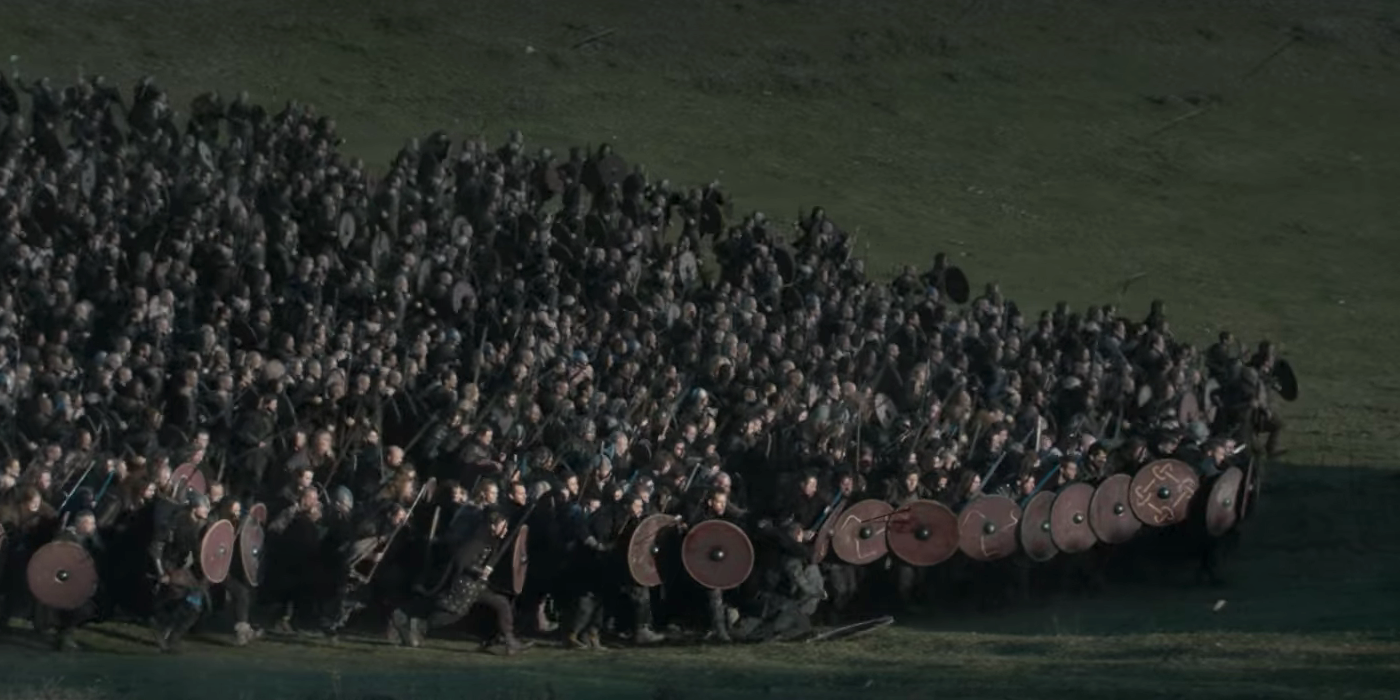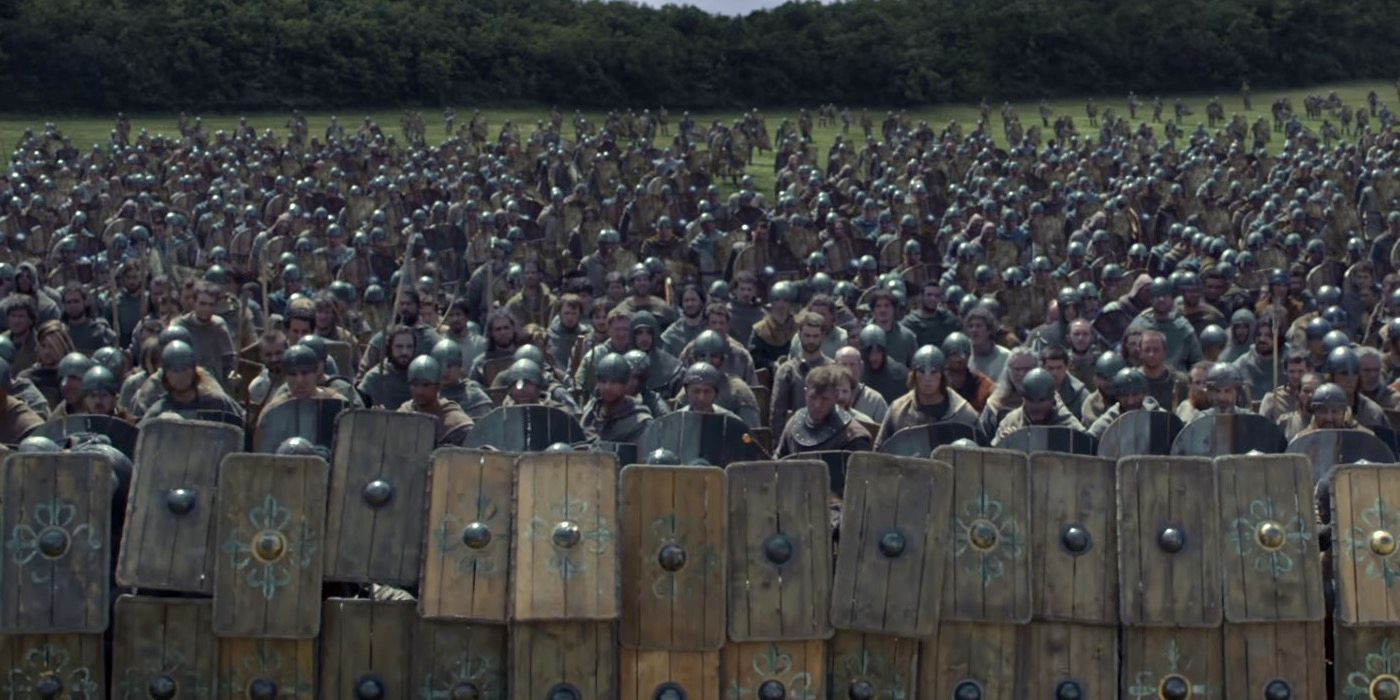
Just as in the rest of The Last Kingdom series, Seven Kings Must Die takes liberties with the established chronology of real events. In the movie, the drama starts with King Edward’s death, leaving a power vacuum at the heart of England. In the movie, the timeframe suggests that the decisive battle between Aethelstan and other would-be successors happens soon after Edward’s passing, whereas in reality, Edward died in 924 and the Battle of Brunanburh happened 13 years later. Despite this change, the role of Brunanburh indicates that the movie ends in 937. However, this was not the end of drama in England.
Aethelstan Dies
939





One of the biggest changes in Seven Kings Must Die is in the characterization of Aethelstan’s reign. The movie suggests that it began with his victory at Brunanburh. The truth, however, is that the battle happened near the end of his time as king, bookending what most historians agree was one of the most successful administrations in medieval England. While the movie identifies the battle as the crucial moment when England was established, the truth is that Aethelstan ruled over a unified kingdom long before the events of Brunanburh and only reigned for two more years after its resolution.
Unsurprisingly, given Aethelstan’s status as a unifying presence and masterful administrator, his death in 939 caused yet more turbulence in England. He was initially succeeded by his half-brother Edmund (939-946), who was in turn followed by Eadred. Both kings had to contend with a northern uprising, which threw Wessex’s control of York into dispute. As such, even though Aethelstan did rule over a unified kingdom (and is widely regarded as the first true King of England), the unity collapsed almost immediately after his death.
Edgar Becomes King
959

Until 959, and as portrayed in The Last Kingdom, Viking invasion was a constant threat in England. Although Edgar’s reign by no means brought an end to the problem, his kingship did coincide with a relative period of peace. Edgar ruled for 16 years in an era historian Frank Stenton described as “singularly devoid of recorded incident“. Predictably, however, this all changed upon his death in 975.
Immediately, there was a heated dispute between supporters of Edgar’s sons Edward and Aethelred. At age 12, Edward was narrowly elected to the throne. However, he was assassinated three years later after a turbulent reign defined by the collapse of the order enjoyed under Edgar.
Aethelred “The Unready” Ascends The Throne
978

Although he reigned for 38 years, Aethelred’s kingship is regarded as one of the worst in English history – culminating in the collapse of Anglo-Saxon rule. Highlighting the cyclical nature of The Last Kingdom‘s story, Aethelred’s main problem was dealing with multiple Viking raids into his kingdom. Although he ruled over a unified England, the same territories that had been harangued by raiders during his predecessors’ administrations continued to suffer under Aethelred. Where he differed, however, was in his total inability to fight back.
In 991, a Viking force sacked the city of Ipswich and demanded a ransom from Aethelred. Initially, the English commander refused, before being comprehensively defeated at the Battle of Maldon. Aethelred then decided to try and buy the Vikings off with “Danegeld” – the term given to coins minted for the purpose of bribing the invaders. Unfortunately, rather than accepting the payment and leaving, the Vikings recognized Aethelred’s weakness and decided to keep coming back for more.
The Real Uhtred Dies
1016





One of the quirks of The Last Kingdom is that, despite featuring real characters, the main protagonist Uhtred wasn’t actually alive when the events of the series took place. Instead, the character is based on the real historical figure Uhtred the Bold, who ruled Bebbanburg from 1006 to 1016. Unsurprisingly, however, there were many differences between Uhtred’s characterization in the show and his real life.
The real Uhtred was not “born a Saxon and raised a Dane,” but was in fact a powerful Anglo-Saxon ruler in the north of England. Not only did he help fight off a Scottish invasion in 1006, but he also became ruler of York when Aethelred had the previous earl Aelfhelm murdered. Thus, Uhtred ruled over an extensive northern territory as Earl on behalf of Aethelred. However, this changed in 1013, when Sweyn Forkbeard, King of Denmark, invaded England and forced Aethelred to flee to Normandy. Uhtred swore allegiance to Sweyn, before campaigning with Aethelred’s son against the Vikings and eventually being murdered by Sweyn’s son, Cnut.
Cnut Becomes King
1016

Aethelred was deposed by Sweyn in 1013, before briefly returning to England in 1014 after the Viking ruler’s sudden death. A power struggle then began between Aethelred and Sweyn’s son, Cnut, with Aethelred ultimately succeeding and reestablishing his rule. However, just two years later, Aethelred was forced to contend with more upheaval as his own son, Edmund, led a revolt against him. This prompted Cnut to return to England and, following Aethelred’s death in 1016, the Viking agreed to split the kingdom between himself and Edmund.
After Edmund’s suspicious death in 1017, Cnut became king of all England and divided the nation up into separate earldoms. Under Cnut, England became part of a huge Viking empire that also encompassed Denmark and Norway. Although England was a single cohesive nation, as envisioned by Alfred in The Last Kingdom, Cnut was not an Anglo-Saxon, having been born in Denmark. This highlights how the hopeful message seen in Seven Kings Must Die‘s ending is not a fair reflection of how history actually panned out.
Reign Of Edward The Confessor
1042

Although Cnut ruled for a long time (1016-1035), he could not establish a lasting Viking dynasty. Upon his death, chaos erupted in both England and Scandinavia, with crises in Denmark and Norway prompting his would-be successors to focus their attention on events on the European mainland. This created a window for Aethelred’s son, Edward, to return from exile in Normandy and take the English crown in 1042.
Edward represents the last king of the House of Wessex, of which Alfred, Edward, and Aethelstan in The Last Kingdom are all members. Despite his relative longevity, his reign is defined by the uncertainty surrounding his succession, which led to a three-way struggle for power between Harold Godwinson – a member of a preeminent Anglo-Saxon family, Harald Hardrada – the King of Norway, and William the Conqueror of Normandy. Although he was not as ineffectual as Aethelred, his failure to produce a definitive heir undoubtedly plunged England into further chaos.
The Normans Invade
1066

Edward the Confessor died on January 5th, 1066, with Harold Godwinson ascending to the throne the following day. However, such was the uncertainty after Edward’s death, that he faced two huge obstacles to his rule. The first was Harald Hardrada, who launched an invasion of England alongside Harold’s exiled brother, Tostig. After the English forces initially suffered defeat, Harold took the invading army by surprise, crushing them at the Battle of Stamford Bridge – killing both Tostig and Hardrada. However, no sooner had the Vikings been defeated, than Harold had to contend with the Normans.
Claiming the crown through his mother’s tenuous connection to Edward the Confessor, much of William the Conqueror’s case for kingship seemed to hinge on Edward allegedly promising him the crown when he had been in exile. The flimsiness of his claim aside, he set sail for England days after Harold had successfully beaten Hardrada. This forced the English king to march his army to the opposite end of the country, making battle at the aptly named Battle, near Hastings. As recorded in the world-famous Bayeaux Tapestry, William inflicted a decisive victory and established himself as the first Norman King of England.
The Last Kingdom‘s ending suggests that England enjoyed relative peace and prosperity following the events of the series and concluding movie. While this was true in periods, real history makes it clear just how turbulent medieval England was, with invading forces and competing dynasties a constant menace until 1066 and beyond. However, while the idea of a satisfying and tidy ending to the story is bogus, England’s status as a kingdom in its own right – despite some changes and disputes – proves that, for all the turmoil, Alfred’s The Last Kingdom dream really did come to pass.





